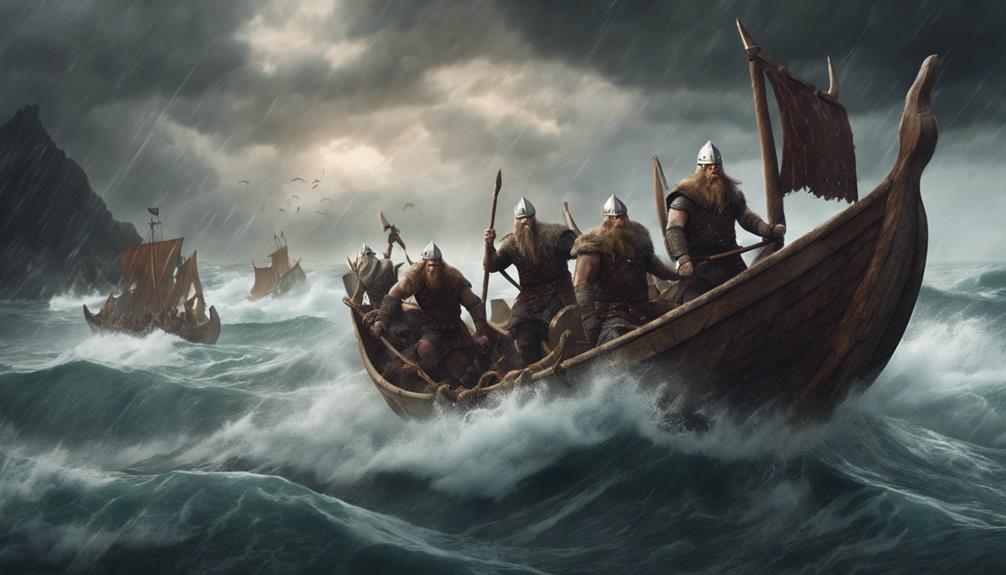The Vikings, often depicted as fierce warriors and seafarers, represent a complex and intriguing chapter in European history. Their impact on trade, exploration, and cultural exchange is undeniable, with their reach extending far beyond their Scandinavian origins. Delving into the intricacies of Viking society, from their social structure to religious beliefs, sheds light on the diverse aspects of their civilization. However, a closer examination reveals nuances that challenge common perceptions of these enigmatic people, prompting a deeper exploration into their legacy and the enduring mysteries that surround their existence.
Key Takeaways
- Vikings were seafaring warriors from Scandinavia with a unique societal structure.
- Their legacy includes exploration, colonization, and significant impact on European culture.
- Viking ships were advanced for their time, aiding in navigation and conquests.
- Norse mythology and religion, centered around powerful gods, shaped Viking beliefs and practices.
Origins of the Viking People
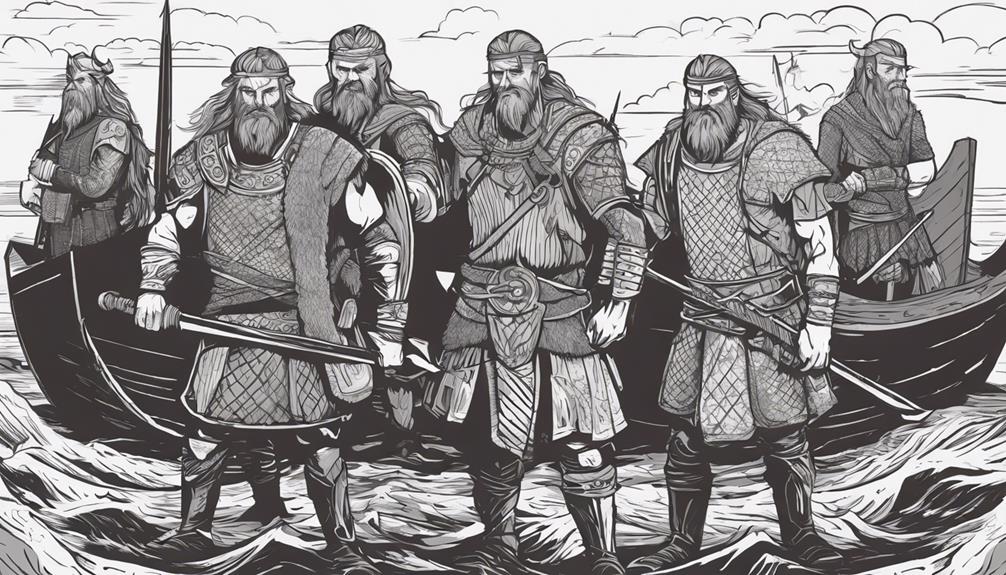
Emerging from the regions of Denmark, Norway, Sweden, Finland, Estonia, and Saami, the Viking people constituted a distinct group characterized by their seafaring prowess, foreign origins, non-Christian beliefs, and reputation as formidable warriors and traders. The term 'Viking' finds its roots in the Old Norse word 'vikingr', denoting a pirate or a raider. These seafaring warriors ventured out from their homelands to explore, raid, trade, and establish settlements in various regions, leaving a lasting impact on European history.
The Viking society was diverse, encompassing individuals from different Nordic countries who united under the common identity of being Vikings. Despite originating from separate regions, they shared similar cultural traits and societal structures. The Vikings' origins in Denmark, Norway, Sweden, Finland, Estonia, and among the Saami people highlight the widespread influence and reach of these seafaring peoples. This diversity within Viking society contributed to their adaptability and success in various endeavors, solidifying their reputation as skilled navigators, traders, and warriors.
Viking Society and Social Structure
Within Viking society, a clear hierarchy structured into three distinct classes governed the roles and responsibilities of individuals: karls, jarls, and thralls.
- Karls were freemen and landowners, responsible for farming and trading activities.
- Jarls, the wealthy nobles, held significant power and authority within Viking communities.
- Thralls, often slaves or bondsmen, had the least amount of freedom and rights, serving the karls and jarls.
- Women in Viking society enjoyed property rights, managed finances, and in some cases, actively participated in battles as shieldmaidens, challenging traditional gender roles.
Viking warriors were known for their distinctive attire, wearing woolen overtunics, linen undertunics, trousers, and leather shoes, paired with spangenhelm helmets and armor such as lamellar or chain mail for combat. The Vikings' social classes were well-defined, with freemen, nobles, and slaves each having specific roles and obligations. This structured social system played a vital role in shaping Viking society and its interactions.
Viking Exploration and Conquests
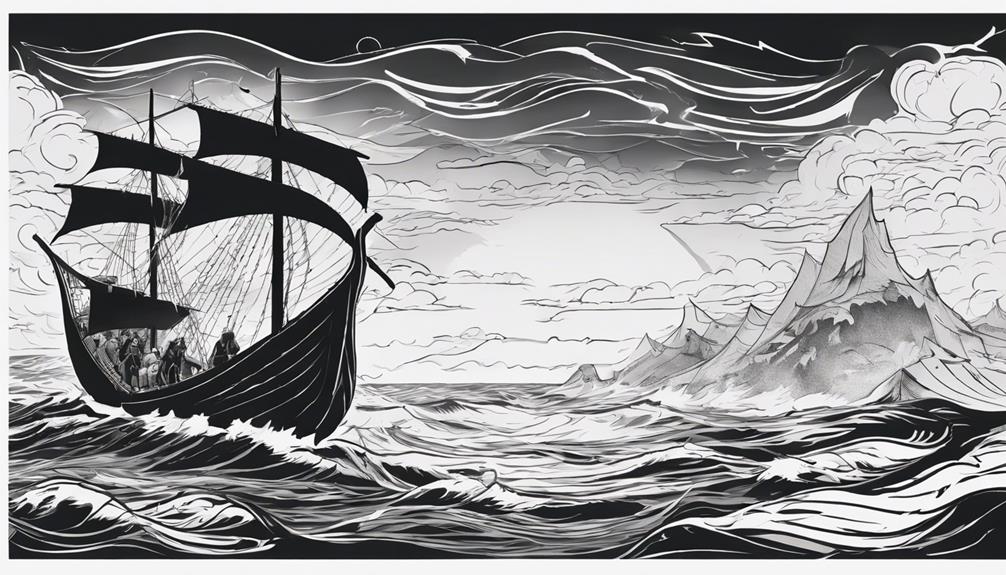
Viking Exploration and Conquests encompassed a period of remarkable maritime expeditions and military campaigns that significantly impacted the cultural and geopolitical landscape of the regions they traversed. Vikings established colonies in Iceland, Greenland, and even ventured as far as North America, with Leif Eriksson's exploration leading to the discovery of Vinland. These Norse explorers were not just settlers; they were also known for their raids and conquests in regions like Ireland, Scotland, and England, leaving a lasting mark on these areas. The archaeological evidence, such as the site at L'Anse aux Meadows in North America, supports the presence of Vikings in these distant lands. Furthermore, the Viking expansion and conquests played a crucial role in shaping European languages, culture, and even the genetic makeup of populations in the areas they reached. The legacy of their exploration and conquests continues to be studied and appreciated for its profound influence on history.
Viking Ships and Navigation
Utilizing long, narrow, and fast vessels characterized by shallow drafts, Viking seafarers mastered the art of shipbuilding and navigation during their maritime expeditions. The Vikings primarily utilized longships and longboats, specifically designed for speed, maneuverability, and carrying capacity. These Viking ships were constructed using clinker-built techniques, featuring overlapping planks that provided flexibility, durability, and the ability to withstand rough seas. A single mast with a square sail propelled these ships forward, allowing them to navigate both rivers and open seas effectively.
- Viking ships were long, narrow, and fast with shallow drafts, enabling navigation in various water bodies.
- The clinker-built construction of Viking ships made them durable, flexible, and suitable for rough sea conditions.
- Celestial navigation, sunstones, landmarks, and natural phenomena were crucial for Vikings to navigate during their voyages.
- Speed and maneuverability were key features of Viking ships, contributing to their success in exploration and trade expeditions.
Viking Religion and Mythology
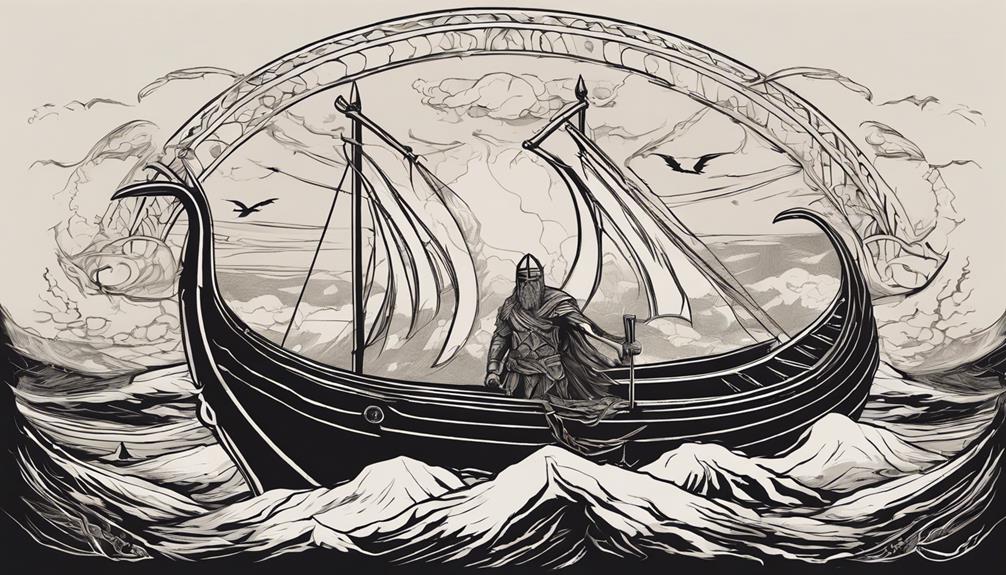
The religious beliefs of the Vikings were deeply rooted in the pagan and polytheistic Old Norse religion, centered around gods such as Odin, Thor, and Freyja. Their mythology included rich accounts of the afterlife, where warriors could aspire to join the ranks of fallen heroes in Valhalla. Additionally, Norse mythology featured a plethora of mythical creatures like dragons, giants, and dwarves, adding layers of complexity to Viking beliefs and storytelling.
Norse Gods Overview
Norse gods played pivotal roles in shaping the religious beliefs and mythological framework of the Viking culture.
- Odin: The chief god associated with war, wisdom, and poetry.
- Thor: Known for his strength and protection against evil.
- Freyja: A goddess of love, fertility, and beauty.
- Loki: A trickster figure who often caused chaos and mischief.
Vikings believed in a polytheistic system where these gods influenced various aspects of life, from battles to harvests. The Norse mythology not only guided rituals but also shaped their understanding of the afterlife, with fallen warriors welcomed in Valhalla and the dishonorable dead in Hel. Stories, poems, and artwork depicted these gods' attributes and adventures, enriching Viking culture with a rich tapestry of divine influences.
Viking Afterlife Beliefs
Viking afterlife beliefs, rooted in their intricate religious and mythological framework, provided a profound insight into the warrior culture's motivations and aspirations. The Vikings believed in an afterlife where fallen warriors would reside in Valhalla, feasting and fighting alongside Odin. For those who did not die heroically in battle, Hel awaited, a realm presided over by the goddess Hel. Additionally, there was Folkvangr, ruled by Freyja, where another group of fallen warriors found their afterlife. Norse mythology, with its pantheon of gods and goddesses like Thor, Loki, and Freyja, heavily influenced these beliefs. The significance of the afterlife is mirrored in Viking runestones and burial practices, underscoring how these beliefs motivated warriors to seek honor and glory in combat.
Mythical Creatures in Viking Lore
Mythical creatures within the realm of Viking lore encompass a diverse range of beings, from dragons and giants to dwarves and trolls, each playing a distinctive role in the rich tapestry of Viking religion and mythology.
- Vikings believed in the Norns, female beings who controlled destiny.
- Sleipnir, Odin's eight-legged horse, symbolized speed in Viking mythology.
- Fenrir, the monstrous wolf, represented chaos and was a significant figure in Viking mythology.
- Valkyries, female figures selecting warriors for Valhalla, held essential roles in Viking belief and mythology.
These mythical creatures not only added depth to Viking stories but also reflected various aspects of Viking culture and beliefs.
Legacy of the Vikings
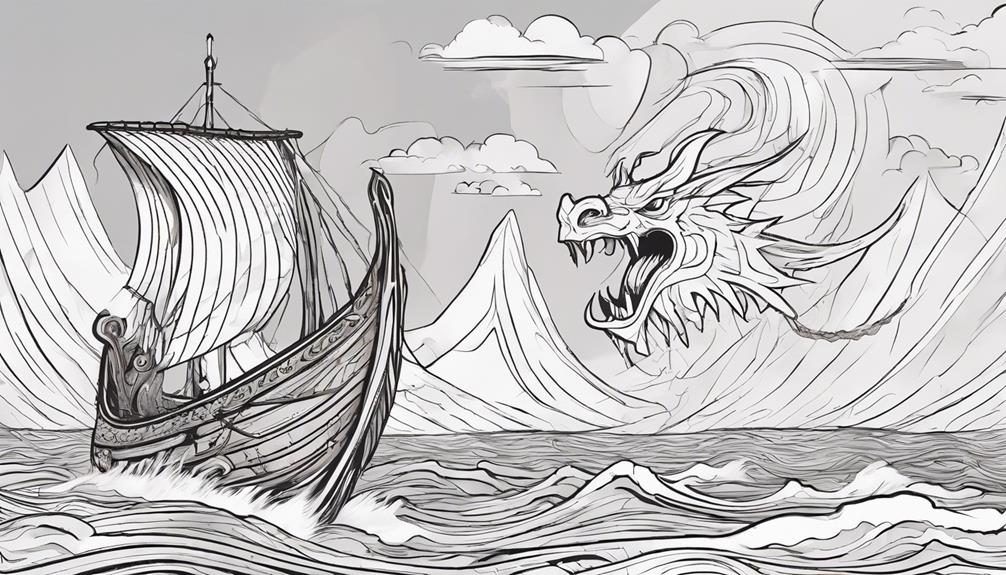
The enduring impact of the seafaring Scandinavian peoples known as the Vikings is evident in the far-reaching influence they left on European languages, culture, and genetic heritage. Viking legacy is seen in the modern-day through the remnants of their language in English and place names across Europe. The Viking culture, characterized by skilled seafaring, exploration, and trading, spread widely through their raids and settlements. Norse mythology and sagas, integral parts of their heritage, were disseminated during their expansion, leaving a mark on storytelling traditions.
Archaeological evidence solidifies the Viking presence, including their settlements in regions like England and Ireland. The Vikings' expansion into North America, supported by findings such as Leif Eriksson's establishment of Vinland, emphasizes their extensive reach. Their influence on European regions is apparent through historical accounts and archaeological discoveries, showcasing their profound impact on shaping the cultural and genetic landscape of Europe.
Common Misconceptions About Vikings
Despite the enduring impact of the Vikings on European languages, culture, and genetic heritage, there exist several common misconceptions about this seafaring Scandinavian people. One prevalent misconception is the depiction of Vikings wearing horned helmets, which is inaccurate as historical evidence shows that their helmets were hornless. The term 'Viking' originally referred to raiders and pirates from Scandinavia during the Middle Ages, not an ethnicity or nationality. Contrary to the image of indiscriminate plunderers, Viking raids were primarily targeted at coastal areas and monasteries for wealth and resources. The decline of Viking activities was influenced by the emergence of nation-states and monetary economies in Europe, leading to the absorption of Viking culture into Christian Europe and marking the end of the Viking Age by 1066. These misconceptions have persisted despite the significant literary legacy left by the Vikings and the nuanced reality of their historical impact.
Frequently Asked Questions
What Ended the Vikings?
Various factors contributed to the end of the Viking era. Climate change, internal conflicts, lack of resources, changing trade routes, declining population, rise of Christianity, economic decline, political instability, and invasions from other tribes all played roles. These combined forces led to a loss of Viking identity and marked the transition towards centralized power and Christian influence in Scandinavia by the late 11th century.
Who Defeated the Vikings?
The defeat of the Vikings can be attributed to King Harald III Sigurdsson's victory at the Battle of Stamford Bridge in 1066. This marked the end of the Viking invasions in England and the decline of their influence in Europe. The spread of Christianity, improved defense systems, and the resilience of local populations played crucial roles in overcoming the Viking warriors' tactics and strategies. This historical battle signaled the cessation of Norse raids and Viking conquests in the medieval period.
Who Were Some Real Vikings?
Viking explorers, Norse warriors, famous raiders, Viking settlers, chieftains, conquerors, kings, legendary warriors, heroes, and Scandinavian seafarers were real historical figures who shaped Viking history. Leif Eriksson, Ragnar Lothbrok, Harald Hardrada, Ivar the Boneless, and Lagertha are among these notable figures. They exemplified the adventurous spirit, martial prowess, navigational skills, and societal complexities of the Vikings, leaving a lasting impact on European history.
Who Were the Vikings Before They Became Vikings?
Before they embraced the title of Vikings, these early Scandinavians, known as Norse settlers, were primarily farmers, traders, and seafarers hailing from Denmark, Norway, and Sweden. Their transition from peaceful existence to becoming Viking ancestors involved a shift towards raiding, trading, and exploration of new territories. They were Proto Vikings, evolving from ancient Scandinavian tribes with a rich Nordic culture, shaping their identity as early raiders in pre-Viking history.
Conclusion
In conclusion, the Vikings were a complex and influential group of raiders, traders, explorers, and settlers from the 9th to 11th century. Their society was structured into different classes, and women enjoyed certain rights and roles. The Vikings' legacy can be seen in various European cultures and languages, with archaeological evidence supporting their presence in regions like North America. Despite common misconceptions, the Vikings were a significant force in shaping the history of the medieval world.
